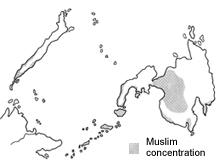

Rugged, faulted mountains and volcanoes occur in many areas. Mount Apo, at 9,691 feet (2,954 m), is an active volcano in the southern part of the central highlands; it is the highest peak in the Philippines. The island has narrow coastal plains, and broad, fertile basins and extensive swamps are formed by the Mindanao and Agusan river systems. Lake Sultan Alonto (formerly called Lake Lanao), created by a lava dam, has an area of 134 square miles (347 square km). The island has a marsh-game refuge and bird sanctuary. The rare monkey-eating eagle is unique to Mindanao.
Mindanao is a Muslim outpost in the predominantly Roman Catholic Philippines. Although Muslims are no longer a majority, Islamic culture is evident; there are many mosques, and distinctive brassware, including the kris, or dagger, is manufactured. The autonomous region of Muslim Mindanao--consisting of territory in western and southwestern Mindanao along with a number of nearby islands, including Tawitawi and Jolo--was established in 1990.
Mindanao also has the largest concentration of ethnic minorities in the Philippines. They include the Magindanaw, Maranaw, Ilanum, and Sangil; all are Muslim groups known collectively as the Moro. Groups usually found in the uplands include the Tagabili, Subanon, Bukidnon, Bagobo, Mandaya, and Manobo. Another important group is the Tiruay, whose religion is a mixture of Christian, Muslim, and animist beliefs.
Because of its large expanses of undeveloped fertile land, Mindanao has been considered the nation's "pioneer frontier." It did not experience substantial population increase until migration was promoted after 1939. The chief crops are corn (maize), rice, abaca, bananas, pineapples, mangoes, and coconuts. Cotton, ramie (a fibre plant), coffee, and cacao are also grown. The timber industry is important, and there are gold, nickel, iron, and coal deposits. Chartered cities include Zamboanga City, Cotabato City, Davao City, Cagayan de Oro, and Butuan. Pop. (1990 prelim.) 13,232,000.
| Mindanao | [mindunä'O, –nou'] Pronunciation Key |
Mindanao , island (1990 pop. 13,535,738), 36,537 sq mi (94,631 sq km), second largest of the Philippine islands, NE of Borneo. About one third of the island's population is Muslim (see Moros). The terrain is generally mountainous and heavily forested, rising to 9,690 ft (2,954 m) at Mt. Apo, an active volcano and the highest point in the Philippines. The island is indented by several deep bays and has a large western peninsula, the Zamboanga or Sibuguey Peninsula. Its main rivers are the Mindanao (known as the Pulangi in its upper course), c.200 mi (320 km) long and navigable by small steamers for c.40 mi (60 km); and the Agusan, c.240 mi (390 km) long. The largest lake is Lake Lanao, for centuries the habitat of Muslim Moros. Off the northeast coast in the Philippine Sea is the Mindanao Trench (c.35,000 ft/10,670 m deep), one of the greatest known ocean depths.
Mindanao lies below the typhoon belt, and its climate is more favorable than that of Luzon to the north. Pineapples, mangoes, bananas, and other fruits are grown, as well as rice and corn. Zamboanga and Davao are the principal cities; Davao is the most important port. There has been considerable industrial growth on the island since the 1960s. The extensive development of the water resources of the Lake Lanao–Agus River basin, including the harnessing of Maria Cristina Falls, has resulted in the establishment of heavy industrial plants, especially in the Iligan area.